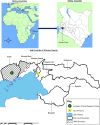Clinical laboratory reference values in adults in Kisumu County, Western Kenya; hematology, chemistry and CD4
- PMID: 33784358
- PMCID: PMC8009432
- DOI: 10.1371/journal.pone.0249259
Clinical laboratory reference values in adults in Kisumu County, Western Kenya; hematology, chemistry and CD4
Abstract
Background: Clinical laboratory reference intervals (RIs) are essential for diagnosing and managing patients in routine clinical care as well as establishing eligibility criteria and defining adverse events in clinical trials, but may vary by age, gender, genetics, nutrition and geographic location. It is, therefore, critical to establish region-specific reference values in order to inform clinical decision-making.
Methods: We analyzed data from a prospective observational HIV incidence cohort study in Kombewa, Kenya. Study participants were healthy males and females, aged 18-35 years, without HIV. Median and 95% reference values (2.5th percentile to 97.5th percentile) were calculated for laboratory parameters including hematology, chemistry studies, and CD4 T cell count. Standard Deviation Ratios (SDR) and Bias Ratios (BR) are presented as measures of effect magnitude. Findings were compared with those from the United States and other Kenyan studies.
Results: A total of 299 participants were analyzed with a median age of 24 years (interquartile range: 21-28). Ratio of males to females was 0.9:1. Hemoglobin range (2.5th-97.5th percentiles) was 12.0-17.9 g/dL and 9.5-15.3 g/dL in men and women respectively. In the cohort, MCV range was 59-95fL, WBC 3.7-9.2×103/μL, and platelet 154-401×103/μL. Chemistry values were higher in males; the creatinine RI was 59-103 μmol/L in males vs. 46-76 μmol/L in females (BRUL>.3); and the alanine transferase range was 8.8-45.3 U/L in males vs. 7.5-36.8 U/L in females (SDR>.3). The overall CD4 T cell count RI was 491-1381 cells/μL. Some parameters including hemoglobin, neutrophil, creatinine and ALT varied with that from prior studies in Kenya and the US.
Conclusion: This study not only provides clinical reference intervals for a population in Kisumu County but also highlights the variations in comparable settings, accentuating the requirement for region-specific reference values to improve patient care, scientific validity, and quality of clinical trials in Africa.
Conflict of interest statement
The authors have declared that no competing interests exist.
Figures

References
-
- Kenyan Ministry of Public Health. Kenya National Strategy for the Prevention and control of non-communicable diseases. Kenya Natl Strateg. 2015;
-
- Thiers FA, Sinskey AJ, Berndt ER. Trends in the globalization of clinical trials. Nat Rev Drug Discov. 2008;7(1):13–4.
-
- Lee EH, Ganesan K, Khamadi SA, Meribe SC, Njeru D, Adamu Y, et al.. Attaining 95-95-95 through implementation science: 15 years of insights and best practices from the walter reed army institute of research’s implementation of the U.S. president’s emergency plan for AIDS relief. Am. J. Trop. Med. Hyg., 104(1), 2021, pp. 12–25 10.4269/ajtmh.20-0541 - DOI - PMC - PubMed
-
- Jaoko W, Nakwagala FN, Anzala O, Manyonyi GO, Birungi J, Nanvubya A, et al.. Safety and immunogenicity of recombinant low-dosage HIV-1 A vaccine candidates vectored by plasmid pTHr DNA or modified vaccinia virus Ankara (MVA) in humans in East Africa. Vaccine. 2008;26(22):2788–95. 10.1016/j.vaccine.2008.02.071 - DOI - PubMed
Publication types
MeSH terms
Substances
LinkOut - more resources
Full Text Sources
Other Literature Sources
Research Materials
Miscellaneous

